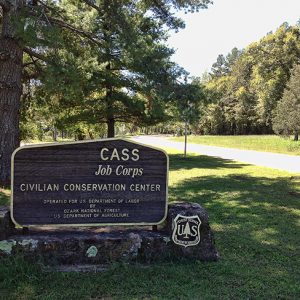calsfoundation@cals.org
Volunteers in Service to America (VISTA)
aka: VISTA
Volunteers in Service to America (VISTA) is a national service program begun in 1965. The volunteers were recruited from all over the country and sent to help people in poverty-stricken areas, including Arkansas. Some of the first areas to receive assistance were Yell County and Texarkana (Miller County). Not only did volunteers help many Arkansans, the written accounts from the time they spent in Arkansas are of great historical value because they describe many details of the rural Arkansas culture of the twentieth century.
The program was begun during Lyndon Johnson’s presidency with the “War on Poverty.” The VISTA program was included in the larger program, the Office of Economic Opportunity, originally called National Service Corps. VISTA was described as a domestic version of the Peace Corps. The goal was to solve the problem of poverty in the United States by increasing access to education and resources in areas with a high poverty level. In his State of the Union Address in 1963, President John F. Kennedy mentioned the benefits such a program could bring to the country. VISTA’s first director was Sargent Shriver, who predicted in 1965 that the program would be so successful that, by 1976, there would be no more poverty in the country. VISTA had more than 2,000 volunteers by the end of 1965. Most of these volunteers were young and middle class. One of the factors that attracted recruits was that they believed that being involved in VISTA would prevent them from getting drafted into the armed forces during the Vietnam War, although this was only partly true; the government would still have to approve the exemption from the draft on an individual basis.
Although volunteers were not required to have any certain level of education or income, the majority of volunteers were college graduates. Volunteers received federal benefits such as health insurance and travel compensation but were not official federal employees and did not receive a salary. They were given training for six to eight weeks and then assigned to an area. Usually, they stayed there a year, although shorter assignments were available. One such shorter assignment was the Associate Volunteer program, which spanned ten weeks during the summer and thus was more convenient for college students. These volunteers participated in an abbreviated form of the program, received less training, and usually worked in the areas where they lived. The first Associate Volunteer program in Arkansas was in 1968, sponsored by Ouachita Baptist University (OBU) in Arkadelphia (Clark County). The director was Jim Ranchino, a professor of political science. Forty-eight students were involved during the first year. In 1969, the program was sponsored by both OBU and the Arkansas Council on Human Relations and had become one of the largest of its type in the country.
Arkansas was one of the first areas to be selected to receive assistance from VISTA due to the high rate of poverty and the low education level. According to a May 7, 1969, Arkansas Gazette article, forty-one percent of Arkansans over the age of twenty-five had never finished eighth grade. Two of the first projects in Arkansas were two Job Corps Conservation Centers, one in Garland (Miller County) and the other in Cass (Franklin County). They were funded by the U.S. Forestry Service and served as residential programs for teen boys from across the country. The boys were given an education as well as a place to live. Another early VISTA project in Arkansas was the Crowley’s Ridge Development Council, which was located in Jonesboro (Craighead County) and served Greene, Craighead, Jackson, and Poinsett counties. It was begun in 1969 and is still a successful anti-poverty program for northeast Arkansas.
The first physician in the nation to serve through VISTA was Dr. Dan Blumenthal. His wife was a child-development specialist. They, along with other volunteers including Jan Wrede, a teacher, and Corinne Cass, a nurse, began the Lee County Co-operative Medical Clinic in Marianna (Lee County) in 1969. The clinic was a controversial project for its time because it treated both black and white patients.
Thousands of volunteers worked in Arkansas, and many of them kept notes and diaries of their observations about the communities they served. One such volunteer was Myrtle Cress, a teacher from Kansas who came to the rural town of Ola (Yell County). She reported that one of the biggest challenges was the difference between the vocabulary the children learned in school and that which they spoke and heard at home. She compared their difficulty of learning “book English” to learning a new language. As well as teaching school children, she donated her granddaughter’s outgrown clothing. Another teacher, Jon Pelkey, who tutored boys in the Russellville (Pope County) area who were unable to attend school, said that the division between the rich and the poor and between the religious and the non-religious was a barrier. Segregation also was an issue during the early years of VISTA. White volunteers were often criticized by communities for associating with black families.
The VISTA program has gone through many changes. When Richard Nixon succeeded Johnson as president, he restructured the program, replacing the Office of Economic Opportunity with ACTION. During the 1970s, VISTA gradually became more local, with volunteers serving in the areas where they lived rather than being assigned far from home. The program was changed again when Jimmy Carter became president. VISTA was incorporated as part of AmeriCorps in 1993 and is still active nationwide, with more than 1,200 projects across the fifty states and several territories, including Puerto Rico, Guam, and the Virgin Islands. In 2005, VISTA took part in the reconstruction of New Orleans, Louisiana, after Hurricane Katrina. VISTA is involved with Habitat for Humanity, a volunteer organization that builds homes for needy families.
A few of the VISTA projects in Arkansas in the twenty-first century are The Learning Center, Inc., of North Little Rock (Pulaski County); Arkansas Land and Farm Development Corporation; and Apple Seeds, which educates people about nutrition and healthy eating.
For additional information:
AmeriCorps VISTA. https://americorps.gov/serve/fit-finder/americorps-vista (accessed February 14, 2022).
Arkansas VISTA Collection. University of Central Arkansas Archives and Special Collections, Conway, Arkansas.
Schwartz, Marvin. In Service to America: A History of VISTA in Arkansas, 1965–1985. Fayetteville: University of Arkansas Press, 1988.
———. “Laughing at Trouble.” Arkansas Times, July 1986, pp. 28–30, 54–57.
“State VISTA Program, Called Best in Nation, Also to Be the Largest.” Arkansas Gazette, May 7, 1969, p. 1B.
Anastasia Teske
North Little Rock, Arkansas
 Arkansas River Valley Area Council (ARVAC)
Arkansas River Valley Area Council (ARVAC) Central Arkansas Development Council
Central Arkansas Development Council Divergent Prosperity and the Arc of Reform, 1968–2022
Divergent Prosperity and the Arc of Reform, 1968–2022 Cass Job Corps Center
Cass Job Corps Center 



Comments
No comments on this entry yet.